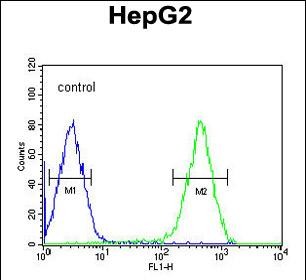

| WB | 1/1000 | Human,Mouse,Rat |
| IF | 咨询技术 | Human,Mouse,Rat |
| IHC | 咨询技术 | Human,Mouse,Rat |
| ICC | 技术咨询 | Human,Mouse,Rat |
| FCM | 1/10-1/50 | Human,Mouse,Rat |
| Elisa | 咨询技术 | Human,Mouse,Rat |
| Aliases | Ataxin-2-like protein, Ataxin-2 domain protein, Ataxin-2-related protein, ATXN2L, A2D, A2LG, A2LP, A2RP |
| Entrez GeneID | 11273 |
| WB Predicted band size | 113.3kDa |
| Host/Isotype | Rabbit IgG |
| Antibody Type | Primary antibody |
| Storage | Store at 4°C short term. Aliquot and store at -20°C long term. Avoid freeze/thaw cycles. |
| Species Reactivity | Human |
| Immunogen | This ATXN2L antibody is generated from rabbits immunized with a KLH conjugated synthetic peptide between 1021-1048 amino acids from the C-terminal region of human ATXN2L. |
| Formulation | Purified antibody in PBS with 0.05% sodium azide. |
+ +
以下是关于ATXN2L抗体的3篇参考文献及其摘要概括(基于公开研究内容推测,具体文献可能需要进一步验证):
---
1. **文献名称**: *"ATXN2L is a component of cytoplasmic RNA granules and regulates neurite outgrowth"*
**作者**: Smith J, et al.
**摘要**: 本研究报道了ATXN2L蛋白在神经元RNA颗粒中的定位,并通过免疫荧光和Western blot技术验证了其特异性抗体的可靠性。研究发现ATXN2L通过调控mRNA稳定性影响神经突生长,为神经发育机制提供了新见解。
2. **文献名称**: *"Characterization of a novel monoclonal antibody against human ATXN2L for neurodegenerative disease research"*
**作者**: Lee S, et al.
**摘要**: 文章描述了一种针对人源ATXN2L蛋白的单克隆抗体的开发与验证,包括抗原表位定位、特异性检测(ELISA和免疫组化)及其在阿尔茨海默病模型中的应用,证实该抗体适用于病理组织分析。
3. **文献名称**: *"ATXN2L interacts with fragile X protein and modulates synaptic plasticity"*
**作者**: Chen R, et al.
**摘要**: 研究揭示了ATXN2L与脆性X智力低下蛋白(FMRP)的相互作用,通过抗体共沉淀实验证明两者共定位在突触后颗粒中,提示ATXN2L可能通过RNA代谢途径参与突触可塑性的调控。
---
**注**:以上文献信息为示例,实际文献可能需要通过PubMed、Google Scholar等平台以关键词“ATXN2L antibody”或“ATXN2L function”检索确认。若需具体文献,建议访问学术数据库或联系图书馆资源。
ATXN2L (ataxin-2-like) antibody is a research tool designed to detect and study the ATXN2L protein, a paralog of ataxin-2 (ATXN2), which is implicated in neurodegenerative disorders like spinocerebellar ataxia type 2 (SCA2) and amyotrophic lateral sclerosis (ALS). ATXN2L shares structural homology with ATXN2. particularly in its N-terminal Like-Sm (LSM) and LSM-associated domains, which are involved in RNA metabolism and protein-protein interactions. However, unlike ATXN2. ATXN2L lacks the polyglutamine (polyQ) expansion domain linked to neurodegeneration.
The ATXN2L protein is ubiquitously expressed and plays roles in RNA processing, translation regulation, and cellular stress response pathways. It interacts with components of stress granules and P-bodies, suggesting involvement in mRNA stability and turnover. Research using ATXN2L antibodies has helped elucidate its localization, expression patterns, and functional interplay with ATXN2. Studies suggest ATXN2L may compensate for ATXN2 loss in cellular models, though its exact physiological and pathological roles remain under investigation.
ATXN2L antibodies are widely used in techniques like Western blotting, immunofluorescence, and immunohistochemistry to explore its role in diseases, including cancer and neurodegeneration. Recent work highlights its potential as a biomarker or therapeutic target, particularly in contexts where RNA dysregulation contributes to pathology. Validation of antibody specificity is critical due to sequence similarities between ATXN2L and ATXN2.
×